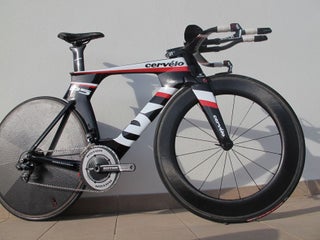New perk! Get after it with local recommendations just for you. Discover nearby events, routes out your door, and hidden gems when you sign up for the Local Running Drop.
The integrated tri bike from Cervélo is finally here. The undisputed people’s champion of triathlon bikes has once again catapulted itself to the forefr
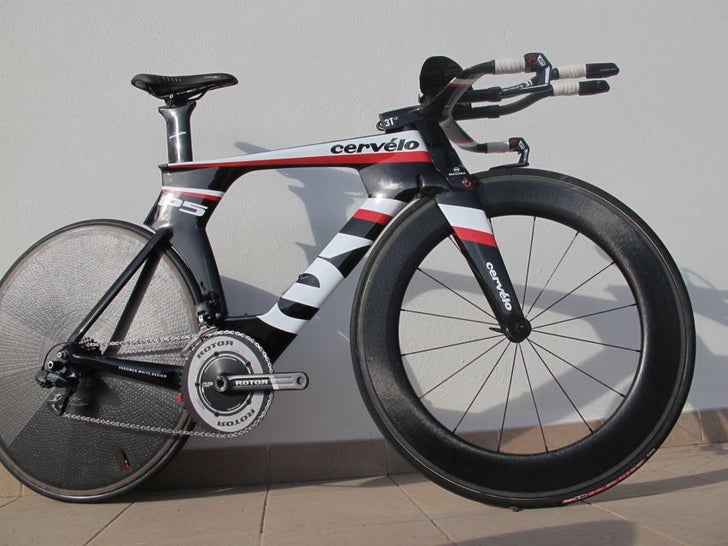
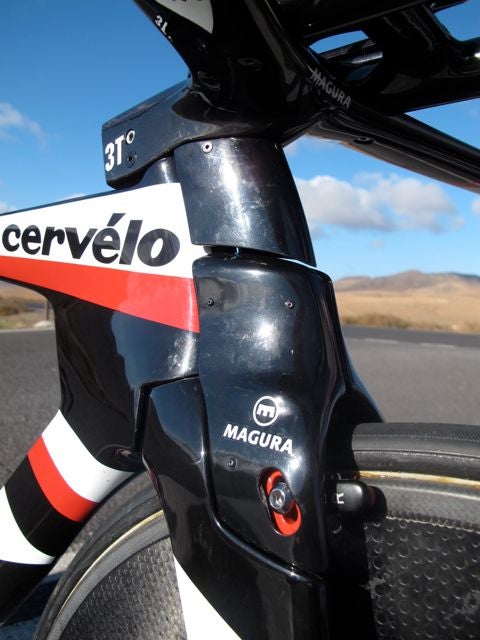
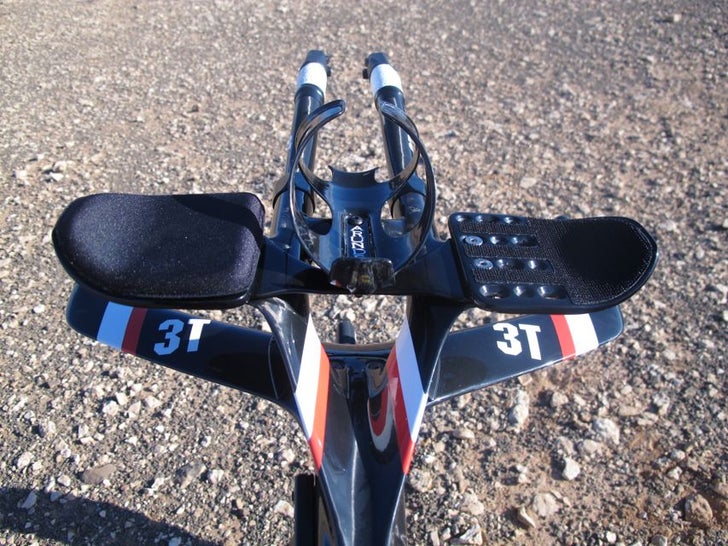
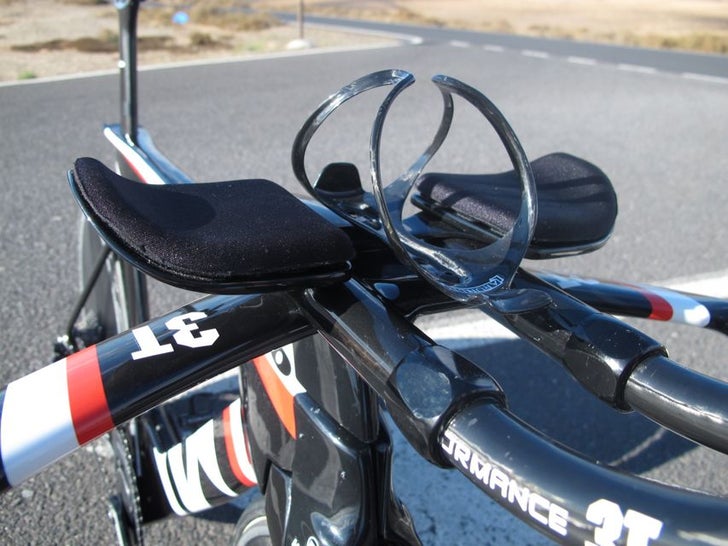
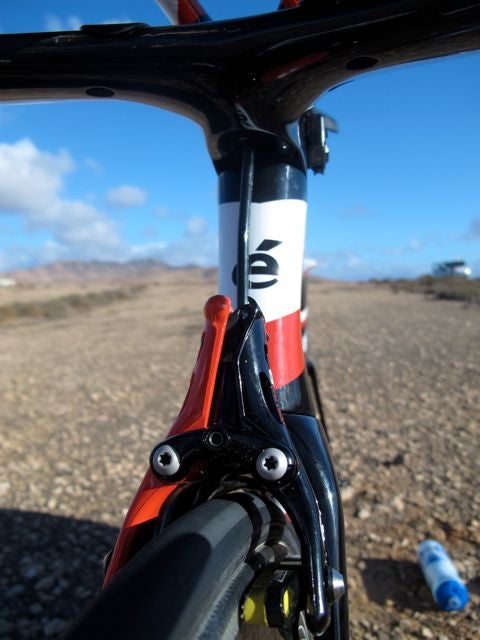
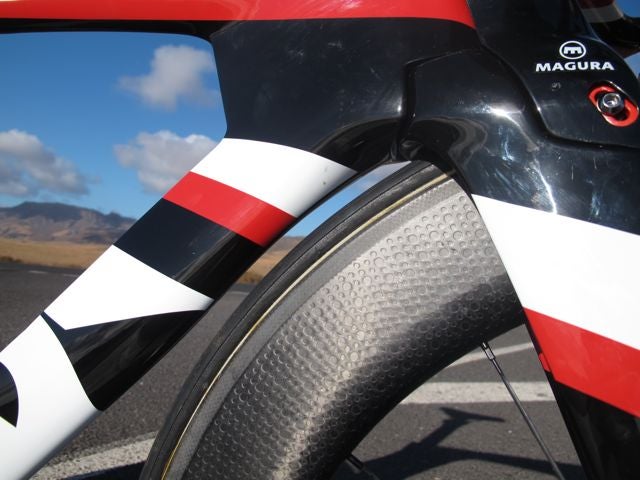
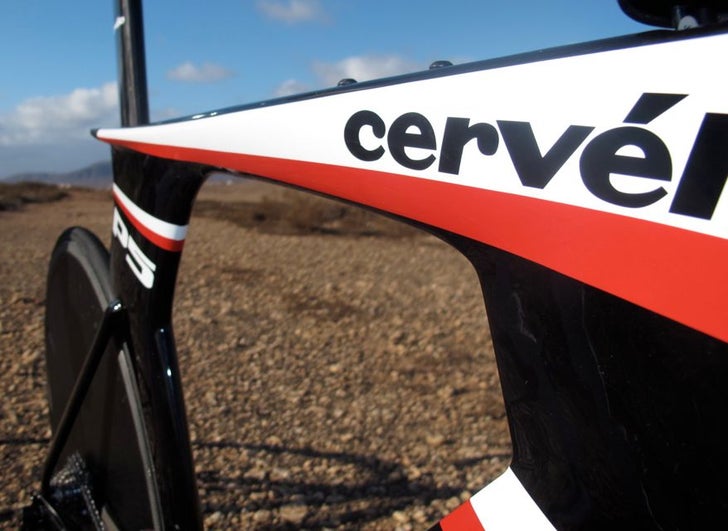
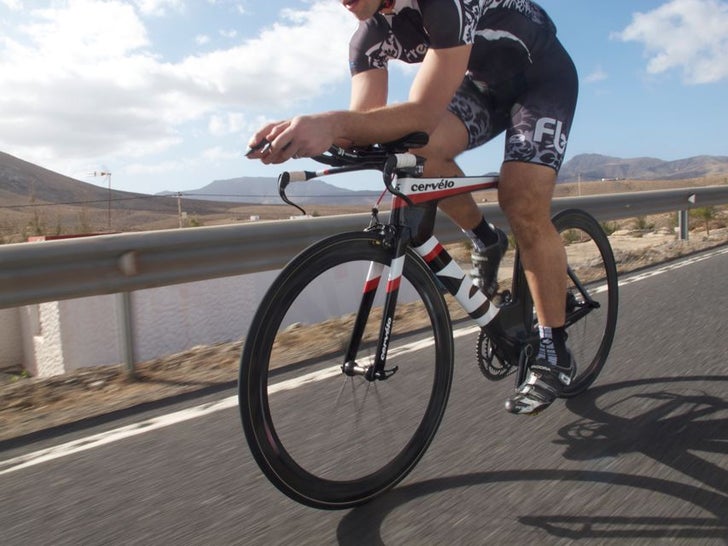
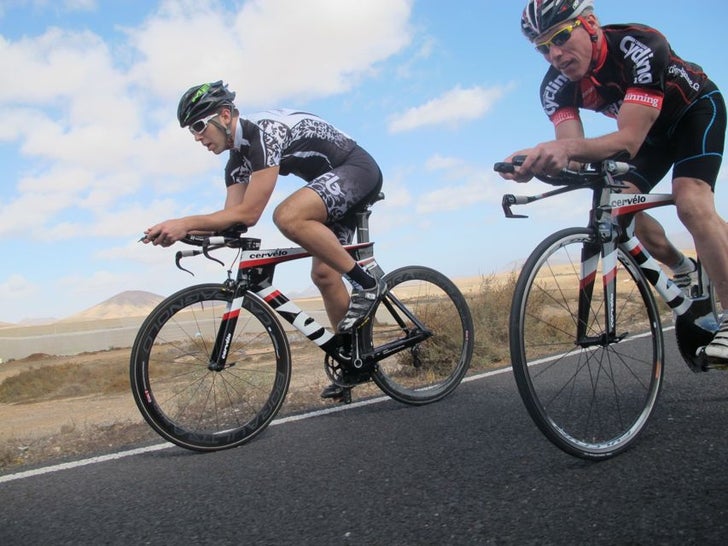
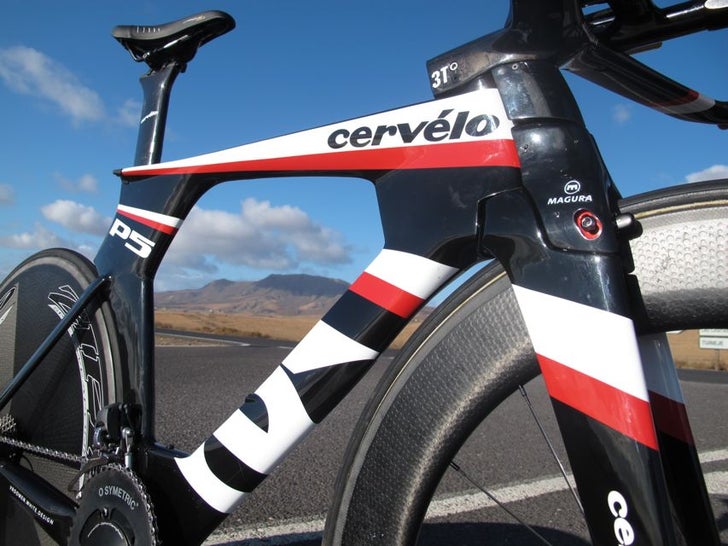
ont of tri bike technology and innovation with its newest creation, the P5. An unprecedented braking system, a shift in geometry style and exceptionally responsive ride feel combined with Cervélo’s ability to create aerodynamic bikes makes the P5 a blockbuster. Its fit adjustment range, however, has one major limitation.
Frame Shape
The frame is UCI-legal. Cervélo offers a triathlon-specific fork that is not. The frame conforms to the regulations stating that tubes must be no more than three times deeper than their width, but Cervélo used a loophole to stretch the seat tube beyond the typical interpretation of the rule. Cervélo senior advanced R&D engineer Damon Rinard says the UCI allows “gussets” that support and connect the frame tubes as long as they are no deeper than the original tube dimension. The P5’s seat tube is 27mm wide, which means it must be 81mm or shorter in the longest direction, and the seat tube is almost exactly that length. The gusset connecting the seat tube and the top tube, however, is another 81mm. These connected elements create a surface that is 162mm at its longest point. A second gusset is used to connect the seat stays to the seat tube that extends the segment of the tube deeper than the UCI’s 3:1 ratio lower on the seat tube. At its widest point, the P5 actually has a 6:1 ratio, yet it still abides by the UCI’s 3:1 rule. Go figure.
Cervélo contends that building a bike with a single tube shape doesn’t make sense. The rider’s body and wheel influence the air flowing around the bike in different ways at different sections of the bike, so Cervélo broke the bike into discrete segments to design shapes optimized for each condition. As a result, the P5 has different tube shapes from the aerobar to the back of the frame. They’re sticking with a teardrop-shaped airfoil instead of a truncated airfoil design for the downtube and aerobar, but some portions including the seat tube have a chopped, flat tail.
The same P5 frame is used for both the triathlon versions and road time trial versions of the bike. As a result, Cervélo did not use outrageously deep profiles for the downtube or head tube such as those on the Quintana Roo Illicito and Specialized Shiv. The triathlon fork, however, is extremely deep. The fork blades and the extension off the front of the bike both create airfoil shapes much deeper than the road version. We tested both bikes in very windy conditions and noticed a slightly greater influence from the wind on the triathlon version.
Cervélo elected to stick with horizontal dropouts, which make wheel removal and reinsertion more difficult than vertical dropouts. These dropouts also allow the gap between the seat tube and the tire to be finely adjusted. Rinard says a gap of 2-6mm is aerodynamically ideal and there is no performance difference within that range, taking into account the rotational aerodynamic resistance against the wheel in its direction of motion created when the air moving with the tire collides with the frame. Hexagonal head screws are sunken into the dropouts. They can be backed out to space the wheel away from the frame to widen the gap or accommodate a 25c tire. The bike is optimized for 23mm tires and when the screws are all the way in the bike, tires of this width fit precisely with the frame. The 27mm-wide seat tube is another change Cervélo made from the P4 to the P5 because of the trend to wider wheels and tires. The P4’s seat tube is 25mm wide, a shape that is optimal for narrower tires, but the P5’s is 27mm at its widest point. The broader tube helps smooth airflow from the frame to the tire and should also improve lateral stiffness.
Brakes
Cervélo teamed up with Magura to create a hydraulic rim brake for the P5. Cables are out. Magura, a premier MTB brake manufacturer and the sole supplier of all BMW motorcycle brakes, designed a hydraulic stopping system that is compatible with all road wheels and mounts to any standard triathlon basebar. Amazingly, these hydraulic brakes are lighter than cable brake systems.
Although standard brake cables and housing both feel solid in-hand, the pressure applied
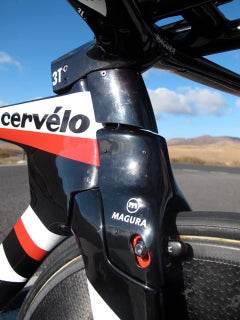 through the cable and housing stretches the brake cable and compresses the housing, resulting in a mushy feeling and greater lever travel under hard braking. As the cable slides within the housing it creates friction that further hampers brake performance, a problem that has become more common thanks to the proliferation of hidden and integrated brakes. Anyone who has ridden a triathlon bike with extremely tight or circuitous brake cable routing is all too aware that a brake with twisted housing lacks stopping power and lags before reopening after braking. Once a few drops of sports drink leak into the housing, braking performance becomes even worse.
through the cable and housing stretches the brake cable and compresses the housing, resulting in a mushy feeling and greater lever travel under hard braking. As the cable slides within the housing it creates friction that further hampers brake performance, a problem that has become more common thanks to the proliferation of hidden and integrated brakes. Anyone who has ridden a triathlon bike with extremely tight or circuitous brake cable routing is all too aware that a brake with twisted housing lacks stopping power and lags before reopening after braking. Once a few drops of sports drink leak into the housing, braking performance becomes even worse.
Hydraulic brakes solve all of those problems. Although bikes with straight and simplistic brake routing certainly reduce the problems with cable-actuated brakes, a single ride aboard a mountain bike with hydraulic disc brakes makes the potential of hydraulic brakes immediately obvious, even though these are rim brakes, not disc.
The Cervélo P4’s rear brake, one of the first truly integrated calipers, suffers from those issues and the Canadian company wanted a better solution for the P5. Rather than starting from scratch to design a hydraulic brake itself, Cervélo approached Magura and suggested the two companies work together to create a hydraulic brake for the P5. Magura handled the hydraulic mechanism and Cervélo integrated the brake into the bike.
Cable braking systems use pulling force to squeeze the rim but hydraulic systems only push, they can’t pull. Hydraulic systems functions like this: A plunger is pushed into the hydraulic line running through the basebar when the rider squeezes the brake lever and forces fluid (the RT 8TT uses mineral oil) through the line. This fluid doesn’t compress and a twisted line doesn’t impair its movement, so the hydraulic line transmits all the pressure to the far end of the system, which actuates the brake. This fundamental change from pulling to pushing forced Magura to design a unique road caliper that functions with a hydraulic system. The Magura RT 8TT brake caliper has a piston that sits beneath two brake arms that actuate about pivot points above the piston. The piston drives upward and forces the upper segment of the arms outward to the sides, which rotates the brake arms and forces the lower portion to squeeze inward toward the rim.
piston. The piston drives upward and forces the upper segment of the arms outward to the sides, which rotates the brake arms and forces the lower portion to squeeze inward toward the rim.
Magura claims the RT 8TT can create 44 percent more force than the nearest competitor listed in their presentation. On the road, it feels substantially more powerful and responsive than a cable-actuated brake. Perhaps the biggest difference in braking feel is the way stopping power ramps up with only a small increase in the pressure on the lever. Instead of putting a death grip on the brake lever to max out the brake caliper’s stopping force, the RT 8TT requires only a subtly tighter squeeze on the lever. Although it would certainly be easier to flip ass over teakettle with these brakes than with cable brakes, stopping power isn’t excessive or jerky. With just a little experience, we were able to quickly adjust our internal gauge for the pressure needed to slow the bike. These brakes are not, however, as powerful as hydraulic disc brakes on mountain bikes and they have a little more give when squeezing the rim as well. Although they don’t offer the same stopping performance of a hydraulic disc brake, they are strong and offer a supremely consistent, reliable connection with the brake caliper. They are a fantastic improvement over any other hidden or integrated brake. Don’t be surprised if every high-end triathlon bike comes with hydraulic calipers within a few years.
In addition to stopping performance, the RT 8TT is remarkably easy to install and use. The calipers attach to any standard brake mount with a standard brake bolt. Their width can be adjusted to fit rim between 17mm and 28mm wide by turning an easily accessible bolt with a 2.5mm hexagonal wrench. This range of rim widths is wide enough to cover every wheel we are aware of. Magura doesn’t yet produce brake shoes (the part that holds the pad) or pads, but the brake arms take any standard brake shoe. A set of Shimano or Sram brake shoes will mount to the RT 8TT and brake pad angle can be adjusted to match any wheel.
In addition to the width adjustment, the brakes have a quick release switch for easy wheel removal. Should the rider forget to reengage the brakes before jumping on the bike, the brake will automatically reengage itself.
Magura says its complete braking system—calipers, levers, and the connection between the two—weighs 495 grams and “one of the lightest” cable systems weighs 519 grams. They explain that a meter of housing and cable weighs roughly 70 grams, but an equal length of their hydraulic line and fluid weighs only 50 grams.
Shimano Dura-Ace Di2 riders will have to sacrifice their brake-mounted shifters or splice an additional shifter into their system to retain the ability to shift while riding with hands on the basebar. Other than price, the inability to use these Di2 shifters is about the only drawback we can find to these brakes.
Magura doesn’t yet produce a splitter that would allow for a third brake lever that could be installed on the aerobar extensions.
The brakes are only available with aero brake levers for now, but Magura product manager Stefan Pahl says, with a smirk, that they will offer road-compatible versions “not too far in the future.” Magura will also release a cheaper version called the RT 6TT that is functionally identical to the RT 8TT but heavier.
The brake lines must be bled periodically to remove any air that makes its way into the line, but these brakes should require less service than cable brakes. They must be centered using the brake bolt only. There is not fine lateral adjustment of the pads.
The RT 8TT will come exclusively on the Cervélo P5 until April 1. On that day, Cervélo dealers will receive components for aftermarket sale at the kingly price of $750 a set, without pads or brake shoes. Dealers that do not carry Cervélo will have access in June and other bike companies will be able to spec the brakes as part of their complete builds in 2013.
Bike Fit
Cervélo hasn’t yet shared the frame geometry chart. We expect to have it by the end of Wednesday. White described the frame geometry as somewhere between the P4 and the P2, but closer to the P2’s more conservative geometry scheme.
Aerobar And Aerobar Fit
The 3T Aduro aerobar, a completely new bar with an integrated 9cm stem, comes stock on the P5. It attaches to the bike using a standard 1 1/8-inch steerer tube. An advantage of this traditional system is that the rider can opt to use any other bar.
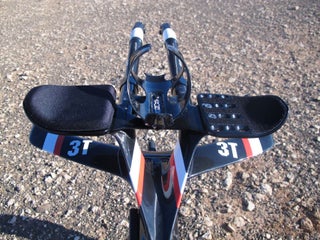 The Aduro can be set up in three stack height configurations. Cervélo calls them X-Lo, Low and High V. Combined they create 11.5cm of total stack adjustment for each of the six frame sizes with the aero-shaped spacers that can be used to elevate the bars. These spacers are available in 5mm and 10mm heights. All three configurations use the same basebar.
The Aduro can be set up in three stack height configurations. Cervélo calls them X-Lo, Low and High V. Combined they create 11.5cm of total stack adjustment for each of the six frame sizes with the aero-shaped spacers that can be used to elevate the bars. These spacers are available in 5mm and 10mm heights. All three configurations use the same basebar.
In the X-Lo position, the bar is flipped upside down. This limits the pad fore-aft position to one fixed spot, eliminating all pad reach adjustment.
The low position keeps the basebar in its upright orientation and the pads can be set to three different fore-aft positions. The total reach range is 50mm from the forward-most setting to the furthest rearward.
The High-V setup has the same reach adjustment as the Low setting. It uses a carbon V-shaped spacer to elevate the bars 5cm farther above the basebar.
The brake grip position is identical for all three configurations and cannot be adjusted. The basebar’s straight brake grips are 40cm wide, center to center. The grips do not tip upward, so riders who are accustomed to upturned brake grips might feel initially unsecure on the grips. With a few rides, that perception goes away. The High V spacer used to elevate the pads to their tallest extreme doesn’t elevate the basebar, creating a more extreme drop from the aero position to the braking position.
Cervélo’s front-end system with the Aduro aerobar offers an enormous range of stack adjustment, but arm pad reach adjustment is limited to the three pad positions on the aerobar. This will be a limitation that may force some riders to switch aerobars to fit the P5. Despite the restricted range of adjustment, we found the pads to be supremely comfortable if they fit the rider’s position. They are long enough to minimize pressure on the arm and angled perfectly to guide the forearm to the extensions.
S-bend aerobar extensions are stock equipment with the P5, and these extensions limit reach adjustment of the handgrip position. The Aduro uses a collet system to clamp the extensions. They plug into a mini extension from the basebar and a piece twists downward to attach the basebar and extension. The S-bend’s curve runs into the collet at a reach distance of 32cm from the rear of the pads in the forward-most position to the tip of the extensions. Swapping the S-bends for ski-tip bars or flat bars will increase fit range by allowing the extensions to come back much farther toward the rider.
Accessory And Storage Integration
The only completely integrated storage container on the P5 is a small box hidden in the seat tube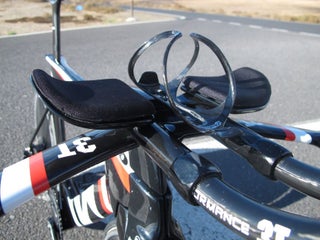 in the rear wheel cutout. Originally designed for a Di2 battery, it can also hold flat repair or other any other small items if the bike is built with a cable drivetrain. In addition to this box, the aerobar has threads to mount a standard bottle cage positioned between the arms. Cervélo has maintained for years that a bottle placed horizontally between the arms is the most aerodynamic location, so they decided to make this bottle position a standard feature. The bottle mount is perfectly solid—it doesn’t rattle in the slightest. The bottle is extremely easy to reach. We loved this simple yet effective feature. The down tube also has a mount for a bottle cage, and that’s the extent of the storage options provided by Cervélo.
in the rear wheel cutout. Originally designed for a Di2 battery, it can also hold flat repair or other any other small items if the bike is built with a cable drivetrain. In addition to this box, the aerobar has threads to mount a standard bottle cage positioned between the arms. Cervélo has maintained for years that a bottle placed horizontally between the arms is the most aerodynamic location, so they decided to make this bottle position a standard feature. The bottle mount is perfectly solid—it doesn’t rattle in the slightest. The bottle is extremely easy to reach. We loved this simple yet effective feature. The down tube also has a mount for a bottle cage, and that’s the extent of the storage options provided by Cervélo.
Although other top-shelf bikes offer more storage or integrated hydration, Cervélo decided to leave the creation of accessories to the hydration companies. The company built solid mounts into the frame to help blend the frame and accessories. They gave X-Lab, TorHans, Dark Speed Works and others an early look at the bike’s unusually positioned bolt mounts so these specialized companies could design products for the P5. Two mounting bolts behind the head tube, one additional bolt beneath the down tube mounts and a seat post mount create a wide range of opportunities for integrated hydration. Dark Speed Works has produced a bento box-style storage container called the Speedpack 480D that mounts behind the stem that is currently available. Some other accessories are already on the way, but they aren’t ready yet. The bike will receive an incomplete grade in this category until those parts have come to market.
Time Trial Vs. Triathlon Versions
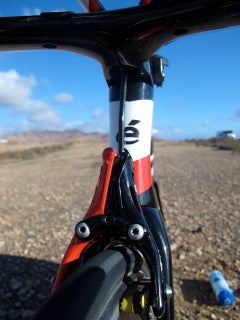 Instead of making both a time trial bike and a triathlon bike with different geometries and tube shapes, Cervélo created a fork specifically for each sport and used the same frame. Both bikes fit identically. The triathlon version has a fairing that covers the hydraulic brake caliper and deeper fork blades. Cervélo showed data from a wind tunnel test comparing the drag created with and without the cover over the caliper. Using a dummy aboard the bike for the test, Cervélo found that the cover saves 7 grams, which equates to roughly one watt. Rinard says the triathlon fork with deeper blades saves an additional 10 grams of drag over the road version. So, all told, Rinard says the drag differences between the two versions amount to roughly two watts, a very small difference.
Instead of making both a time trial bike and a triathlon bike with different geometries and tube shapes, Cervélo created a fork specifically for each sport and used the same frame. Both bikes fit identically. The triathlon version has a fairing that covers the hydraulic brake caliper and deeper fork blades. Cervélo showed data from a wind tunnel test comparing the drag created with and without the cover over the caliper. Using a dummy aboard the bike for the test, Cervélo found that the cover saves 7 grams, which equates to roughly one watt. Rinard says the triathlon fork with deeper blades saves an additional 10 grams of drag over the road version. So, all told, Rinard says the drag differences between the two versions amount to roughly two watts, a very small difference.
Ride
The P5 feels exceptionally stiff under foot yet rides smoothly. It’s noticeably stiffer than its predecessors. Cervélo’s patented bottom bracket technology, a taller head tube, integrated stem and basebar design and selectively wider tubes makes the P5’s ride feel noticeably better than the P4. We were pleasantly surprised with its ability to kick over short hills. Handling is difficult to judge after a single ride, but our initial impression was that the bike is very responsive and not a slow carver. The P5 combines Cervélo’s aerodynamic credibility with an outstanding ride experience on the road.
CFD Replacing Tunnel In Design Development
Using a wind tunnel to design bike shapes by creating and testing prototypes before producing a final bike is now an industry-standard practice that Cervélo pioneered. After years of success with this strategy, they are changing the way they design bikes: Cervélo is going digital.
They have used computational fluid dynamics software to estimate aerodynamic drag for several years, but the quality and speed of their calculations has improved dramatically in the past year. Cervélo co-founder Phil White says CFD “is a math model that breaks the air into tiny little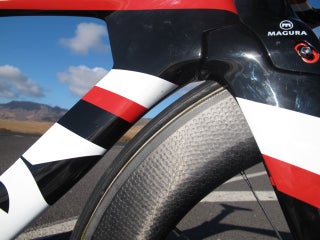 elements and understands what’s happening as each element goes flowing by each other.” Basically, it’s a digital wind tunnel.
elements and understands what’s happening as each element goes flowing by each other.” Basically, it’s a digital wind tunnel.
The shape of a wind tunnel influences the data it generates because the walls and ground influence airflow. CFD programs that don’t account for the interactions with the tunnel itself introduce another layer of uncertainty. Cervélo’s full-time aerodynamicist designed programs that simulate the conditions in various tunnels and, with the corrections for each tunnel shape, Cervélo gained the confidence that their simulations produce accurate info. Their programs are now able to replicate data gathered in a wind tunnel to within 2–3 percent. White says the software still ranks shapes correctly, even if the numbers aren’t always identical to wind tunnel data. Testing shapes using CFD then validating that data in a physical wind tunnel allows them to experiment with more shapes and, therefore, design faster bikes.
Logistics
The very first P5s will arrive in early March. These things are so scarce the journalists at Cervélo’s launch event rode Caroline Steffen’s and Frederik Van Lierde’s bikes. The complete P5 Tri (the name for the version with the triathlon fork) with Dura-Ace Di2 goes for $10,000. The frameset is $6,500. The road version is $6,000 with mechanical Dura-Ace and $4,500 as a frameset.
Cervélo will be releasing the build kits and pricing along with the geometry charts. We will have them posted as soon as possible.
Follow Aaron Hersh @triathletetech
